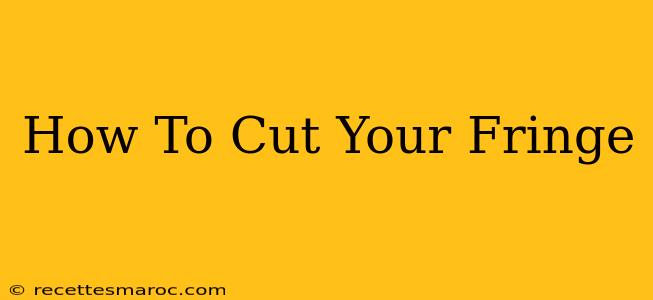So, you're ready to take the plunge and cut your own fringe? It can seem daunting, but with the right tools and technique, achieving a perfectly styled fringe at home is totally achievable. This guide will walk you through the process, step-by-step, minimizing the risk of a DIY disaster. Remember, patience is key!
Preparing for the Big Chop: Gathering Your Supplies
Before you even think about picking up the scissors, make sure you have everything you need. Improvising mid-fringe-trim is a recipe for unevenness and regret. Gather these essential tools:
- Sharp Hair Cutting Scissors: This is non-negotiable. Dull scissors will create split ends and an uneven fringe. Invest in a good pair specifically designed for hair cutting.
- Fine-Toothed Comb: This will help you section your hair accurately and create a neat, even fringe.
- Hair Clips: To keep the rest of your hair out of the way.
- Spray Bottle: Filled with water. Damp hair is much easier to cut than dry hair.
- Mirror: Preferably two – one for a general view and a smaller hand-held mirror for detailed work.
- Optional: Rat-tail Comb: This helps create precise sections.
Sectioning Your Hair: The Foundation of a Great Fringe
This is arguably the most crucial step. An uneven section leads to an uneven fringe, so take your time and be precise.
- Determine Your Fringe Shape: Decide what kind of fringe you want: straight across, side-swept, wispy, etc. This will determine how you section your hair.
- Part Your Hair: Part your hair where you normally would, and then create a section of hair from the center of your forehead to the desired width of your fringe. Use your comb to create a clean, straight part. Clip away the rest of your hair.
- Sectioning for Different Fringe Styles:
- Straight Across Fringe: Make the section as wide or narrow as you prefer your fringe to be.
- Side-Swept Fringe: Make a slightly wider section on one side, allowing for the fringe to be swept to the side.
Cutting Your Fringe: Techniques and Tips
Now for the moment of truth. Remember – less is more! It's always easier to take more off than to put it back.
- Dampen Your Hair: Lightly mist your sectioned hair with water.
- Hold and Cut: Using your comb, hold the section of hair you're cutting straight out from your forehead, ensuring it’s taut. Cut small sections at a time.
- Point Cutting (for softer fringe): Instead of cutting straight across, try point cutting by snipping into the ends at angles. This creates texture and prevents a blunt look, especially helpful for a wispy fringe.
- Check Your Work: Step away from the mirror and look at your fringe from a distance. This helps you see any unevenness that you might miss up close.
- Repeat and Refine: Continue cutting and refining until you achieve your desired shape. You may need to adjust the length or shape several times to get it perfect.
Aftercare: Styling and Maintaining Your New Fringe
Even the perfectly cut fringe needs some TLC to maintain its shape and look its best.
- Styling: Use a small round brush and hairdryer to style your fringe; you may want to add a small amount of hairspray to keep it in place.
- Regular Trims: Get regular trims from a professional stylist, at least every four to six weeks, to maintain the shape of your fringe and prevent split ends.
- Experiment with Styles: Don't be afraid to try different styling products or techniques to achieve the perfect look for your fringe.
Avoiding Common Mistakes
- Cutting Dry Hair: This is a major no-no! Always cut damp hair.
- Cutting Too Much at Once: Start small and gradually trim, allowing for adjustments.
- Using Dull Scissors: This will create unevenness and split ends.
Cutting your own fringe can be a rewarding experience, but remember to be patient and take your time. With these tips and a little practice, you'll be rocking your DIY fringe in no time! Good luck!

